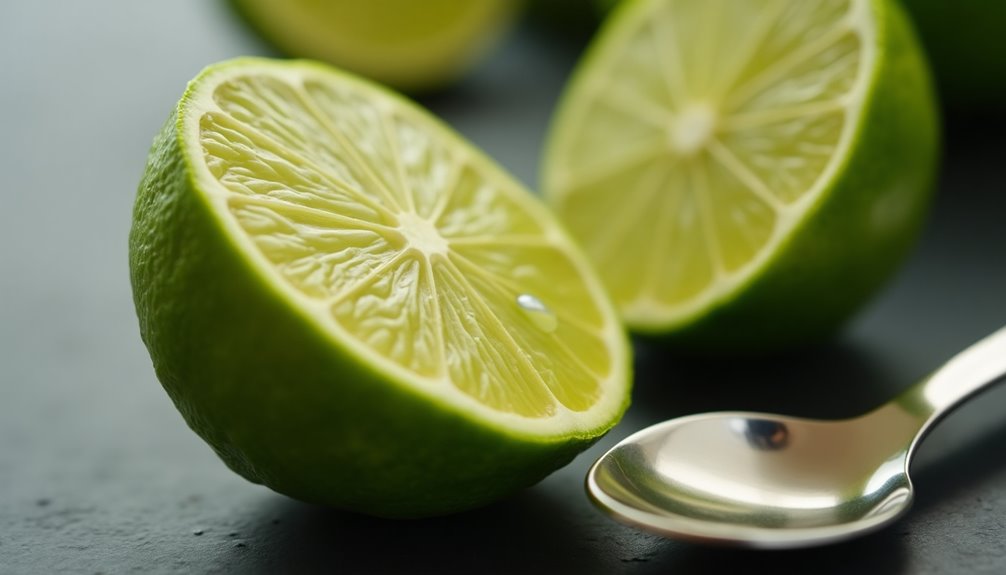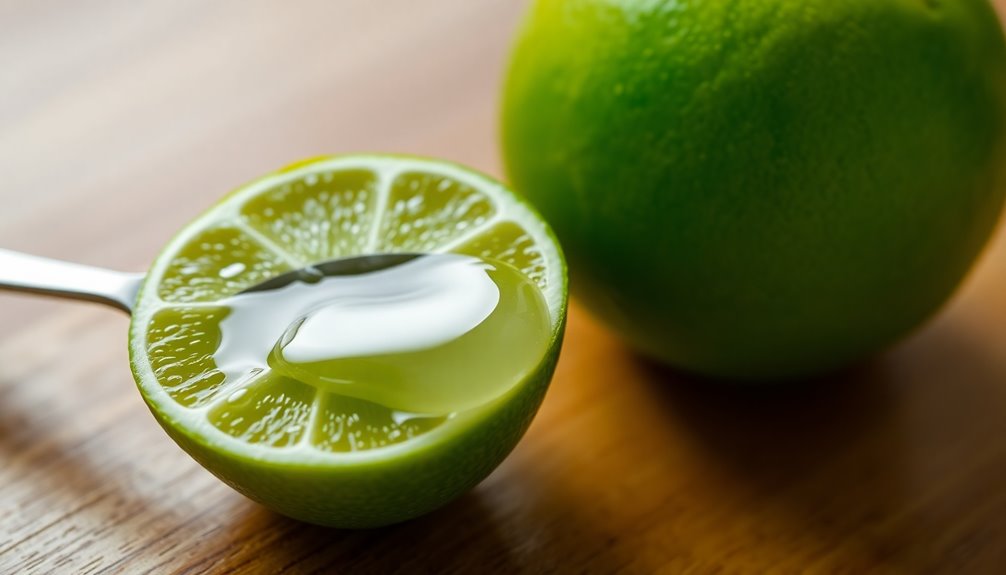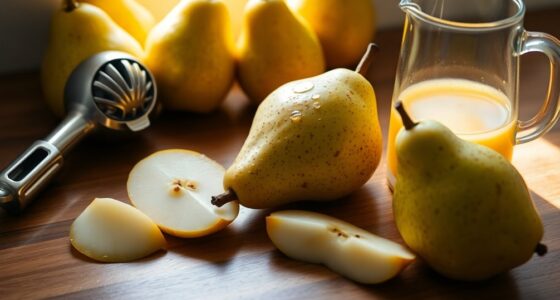A medium lime usually gives you about 2 tablespoons, or 1 ounce, of juice. If you've got a smaller lime, expect around 1 tablespoon from half of it. Juice yield can change based on the lime's size and ripeness, so it's smart to keep a few extras on hand for those unexpected recipe needs. Knowing how to maximize your lime juice will make cooking a breeze, and there's more to discover about this flavorful ingredient!
Key Takeaways
- A medium lime yields about 2 tablespoons (1 ounce) of juice.
- Half a lime produces approximately 1 tablespoon (1/2 ounce) of juice.
- Juice yield can vary based on the lime's size and ripeness.
- For recipes needing 1/4 cup of juice, use about 2 medium limes.
- Have extra limes on hand for unexpected needs or variations in yield.

When you're squeezing a medium lime, you can expect to get about 2 tablespoons, or 1 ounce, of juice. This amount of juice is crucial when you're preparing various recipes that call for fresh lime juice. Knowing how much juice you can extract from one lime can save you time and effort, especially when you're grocery shopping or whipping up a dish in the kitchen.
If you've got a recipe that requires 1/4 cup of lime juice, it's helpful to know that you'll need approximately 2 limes for that. Since 1/4 cup equals 4 tablespoons, and each medium lime yields about 2 tablespoons, two limes will provide just the right amount of juice you need. This is particularly useful when you're in the midst of cooking or baking and want to ensure you have enough lime juice without any guesswork.
The juice yield can vary slightly depending on the size and ripeness of the lime. A half lime generally produces about 1 tablespoon, or 1/2 ounce, of juice. So if you're ever in a pinch and only need a little zest, cutting the lime in half can still get you the fresh lime juice you need without having to squeeze a whole lime. Just remember to use the right amount for your recipe.
When you're prepping ingredients, it's a good idea to have a few extra limes on hand, just in case the recipe calls for more than you anticipated. If you're unsure how many limes to buy, consider the amount of juice you'll need in total. For instance, if your recipe calls for 6 tablespoons of lime juice, you'd want to grab at least 4 medium limes to ensure you have enough, as they typically yield a little less than that.
Understanding lime juice yields can't only improve your cooking efficiency but also help you avoid unnecessary trips to the grocery store. You might find yourself measuring out lime juice for beverages, marinades, or dressings more confidently when you know how to cut the lime and extract just the right amount.
Frequently Asked Questions
How Much Bottled Lime Juice Is Equal to One Lime?
When you're looking to substitute bottled lime juice for fresh, know that 2 tablespoons of bottled juice equals the juice from one medium lime.
Keep in mind that bottled juice can differ in flavor intensity, so taste your dish as you go. For the best results, opt for a high-quality bottled lime juice to ensure it complements your recipe.
Fresh lime juice usually delivers a brighter flavor, so adjust accordingly if needed.
How Much Lime Juice Is 1 Lime?
Imagine standing in a sunlit orchard, plucking a vibrant lime from the tree.
That one lime, bursting with zest, typically gives you about 2 tablespoons of juice.
If you're cooking or mixing drinks, you'll find it's around 1 ounce of liquid sunshine.
How Much Lime Juice Concentrate for 1 Lime?
When you're looking to substitute lime juice concentrate for fresh lime juice, you'll want to remember that one tablespoon of concentrate is roughly equal to the juice from half a lime.
So, if a recipe calls for the juice of one lime, you'll need about two tablespoons of concentrate.
Always taste and adjust to your preference, since concentrate can be more potent and might affect the flavor of your dish.
Can I Use Bottled Lime Juice Instead of Fresh?
Did you know that fresh lime juice can offer up to 20 times more flavor than bottled options?
While you can use bottled lime juice instead of fresh, it's not always the best choice. Bottled juice often lacks the vibrant taste and zest you'd get from fresh limes.
If you're in a pinch, go for organic bottled juice to minimize additives, but remember that fresh is usually the way to go for the best results.
Conclusion
When you're squeezing a lime, you can expect to get about 2 tablespoons of juice from one medium-sized lime. That's enough to add a zesty kick to your favorite dishes or cocktails! Interestingly, did you know that lime juice has about 30 times more vitamin C than lemon juice? So, next time you're reaching for that lime, remember you're not just adding flavor, but also packing in some serious health benefits!
Cindy thoroughly researches juicing trends, techniques, and recipes to provide readers with practical advice and inspiration. Her writing style is accessible, engaging, and designed to make complex concepts easy to understand. Cindy’s dedication to promoting the advantages of juicing shines through her work, empowering readers to make positive changes in their lives through the simple act of juicing.

















